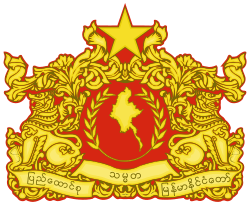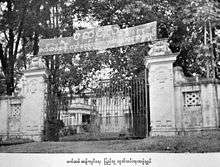Anti-Fascist People's Freedom League
The Anti-Fascist People's Freedom League (Burmese: ဖက်ဆစ်ဆန့်ကျင်ရေး ပြည်သူ့လွတ်လပ်ရေး အဖွဲ့ချုပ်, pronounced [pʰɛʔsʰɪʔ sʰa̰ɰ̃tɕɪ̀ɰ̃jé pjìðṵ lʊʔlaʔjé əpʰwɛ̰dʑoʊʔ]; abbreviated AFPFL or hpa hsa pa la (ဖဆပလ) by its Burmese acronym), was the main political alliance in Burma from 1945 until 1958. It was founded by the Communist Party of Burma (CPB) led by Thakin Soe, the Burma National Army (BNA) led by Aung San, and the People's Revolutionary Party (PRP) (which later evolved into the Socialist Party) at a meeting held between 1–3 March 1945 as a reorganised version of the Anti-Fascist Organisation (AFO), formed to resist the Japanese occupation. The new organisation aimed to resist the Japanese occupation and achieve independence.[1]
Anti-Fascist People's Freedom League ဖက်ဆစ်ဆန့်ကျင်ရေး ပြည်သူ့လွတ်လပ်ရေး အဖွဲ့ချုပ | |
|---|---|
| Chairman | U Nu |
| Founded | 1–3 March 1945 |
| Dissolved | June 1958 |
| Preceded by | Anti-Fascist Organisation |
| Succeeded by | Clean AFPFL Stable AFPFL |
| Ideology | Burmese nationalism Democratic socialism Anti-fascism Burmese independence (until 1948) |
| Political position | Left-wing |
| Colours | Red |
| Party flag | |
 | |
| |
 |
|---|
| This article is part of a series on the politics and government of Myanmar |
|
|
Government
|
|
|
Related topics |
Following internal disputes, the party split into two factions in June 1958, the Clean AFPFL and the Stable AFPFL.
History
Fight for independence

The AFPFL was formed as a reorganisation of the Anti-Fascist Organisation at a meeting held from 1–3 March 1945.[2] When Aung San left the army to re-enter the political arena as a civilian, he became the recognised leader and president of the AFPFL in January 1946.
The AFPFL was a political alliance comprising several very different political parties held together by the common leadership of first Aung San and then U Nu.[3] Its first general secretary was the communist leader Thakin Than Tun.
Dissent and rifts began to appear in the AFPFL over the negotiations regarding strategy and more importantly the nature of independence on offer. Thakin Soe started a rebellion after splitting from the CPB forming a splinter group called the Red Flag Communist Party. The CPB, now dubbed the White Flag Communists, continued to co-operate with the AFPFL, but Than Tun was forced to resign as general secretary in July 1946 and replaced by the socialist Kyaw Nyein, after a split with Aung San and the rest.[4]
Aung San became the de facto premier of Burma in September 1946 when he accepted the British Governor's invitation to lead the Executive Council. The communists accused him and the others of selling out and settling for what they alleged a 'sham independence'.[5] The CPB was then expelled from the AFPFL the following November. The AFPFL negotiated with the British total independence for Burma including the ethnic minorities, and Aung San succeeded in uniting the majority Burmans with the hills peoples at the Panglong Conference in February 1947. Aung Zan Wai, Pe Khin, Bo Hmu Aung, Sir Maung Gyi, Myoma U Than Kywe and Sein Mya Maung were among the negotiators of the conference negotiated with Bamar representative Aung San and other ethnic leaders in 1947. All these leaders unanimously decided to join the Union of Burma.
General elections were held in April 1947, which the AFPFL won convincingly amidst an opposition boycott, taking 173 of the 210 seats and running unopposed in over fifty constituencies. Aung San was set to become Prime Minister, but was assassinated together with six other members of his cabinet on 19 July, a date that later became Martyrs' Day. In his place, U Nu then became both the Premier of Burma and leader of the AFPFL.
Independence and civil war
Burma declared independence from Britain in January 1948, and the CPB went underground the following March after U Nu ordered the arrest of its leaders for inciting rebellion. Other groups also soon dropped out of the AFPFL to join the rebellion, not only the White-band faction of the People's Volunteer Organisation (PVO) formed by Aung San as a paramilitary force out of the demobbed veterans, but also a large part of the Burma Rifles led by communist commanders calling themselves the Revolutionary Burma Army (RBA). The AFPFL government had plunged into civil war with not only Burman insurgent groups but also ethnic minorities including the Karen National Union (KNU), Mon, Pa-O, nationalist Rakhine and the Mujahideen of Rakhine Muslims.
The first post-independence general elections were held over several months in 1951 and 1952, with the AFPFL and its allies winning 199 of the 250 seats in the Chamber of Deputies.
Parliamentary rule and split
Although the AFPFL was returned to office again in the 1956 elections, the results came as a shock as the opposition left-wing coalition, known as the National United Front (NUF) and led by Aung Than, older brother of Aung San, won 37% of the vote and 48 seats in the Chamber of Deputies.
By 1958, despite an economic recovery and the unexpected success of U Nu's 'Arms for Democracy' offer that saw the surrender of a large number of insurgents, most notably the PVO, the AFPFL had become riven with internal splits, which worsened following the party's congress in January 1958. In July 1958 it formally split, with one group led by Prime Minister U Nu, which he named the "Clean AFPFL"; the other was led by Kyaw Nyein and Ba Swe and was known as the Stable AFPFL.[6]
The majority of AFPFL MPs were supporters of the Stable faction, but U Nu was able to narrowly escape defeat in parliamentary motion of no-confidence by only eight votes with the support of the opposition NUF. Still dogged by the 'multicoloured insurgency', the army hardliners feared the communists being allowed to rejoin mainstream politics through Nu's need for continued support by the NUF, and was compounded by the Shan Federal Movement lobbying for a loose federation. The volatile situation culminated in a military caretaker government under General Ne Win that presided over the 1960 general elections, which were won by U Nu's Clean AFPFL.
Following the restoration of multi-party democracy after the 8888 Uprising, two new parties were established using the AFPFL name, the AFPFL (founded 1988)[7] and the AFPFL (Original). Both contested the 1990 elections, but received less than 0.05% of the vote and failed to win a seat.
Policies
During its time in office, the AFPFL pursued a nationalist policy based on unity and consensus, upheld parliamentary democracy and presided over a mixed economy comprising both state and private enterprise. It spent most of this period in its history fighting several communist, socialist and ethnic separatist rebel groups for control over the future of the country. It also fought a successful war against Nationalist Chinese (KMT) forces who occupied the far north of the country for several years after the KMT's defeat by the Chinese Communist Party. Its foreign policy followed strict neutrality supporting the Bandung Conference of 1955,[8] shunning the South-East Asia Treaty Organisation (SEATO) on account of the American support of the KMT on one hand, and facing the communist insurgencies on the other.
Leader of the party
References
- Donald M. Seekins, Historical Dictionary of Burma (Myanmar) (Scarecrow Press, 2006), 75–76: "its founding charter outlined its goals as ridding the country of the 'fascist Japanese' and winning independence".
- Haruhiro Fukui (1985) Political parties of Asia and the Pacific, Greenwood Press, pp108–109
- Marshall Cavendish Corporation (2007). World and Its Peoples: Eastern and Southern Asia. Marshall Cavendish. p. 626. ISBN 978-0-7614-7631-3.
- Thomson, John Seabury (1960). "Marxism in Burma". In Trager, Frank N (ed.). Marxism in South East Asia. Stanford University Press. p. 34. ISBN 978-0-8047-0592-9.
- Johnstone, William Crane (1963). Burma's foreign policy: a study in neutralism. Harvard University Press. p. 27.
- "Tatmadaw's future role history has bequeathed". New Light of Myanmar. 3 April 1995. Retrieved 5 November 2009.
- The Far East and Australasia 2003, p892
- Fleischmann, Klaus (1989). Documents on communism in Burma, 1945-1977. Institut für Asienkunde. p. 244. ISBN 978-3-88910-057-3.
External links
- Woodman, Dorothy (28 February 1948). Burma - free and socialist. New Statesman
- The House on Stilts TIME magazine cover story, 30 August 1954